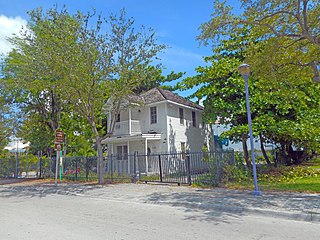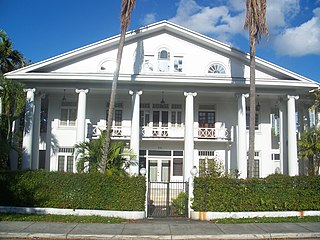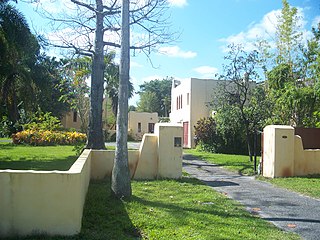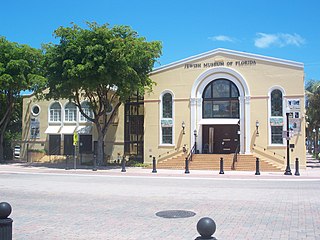This article lacks inline citations besides NRIS, a database which provides minimal and sometimes ambiguous information.(November 2013) (Learn how and when to remove this template message) |
Lua Curtiss House II | |
 | |
| Location | Miami Springs, Florida |
|---|---|
| Coordinates | 25°49′5″N80°17′30″W / 25.81806°N 80.29167°W Coordinates: 25°49′5″N80°17′30″W / 25.81806°N 80.29167°W |
| MPS | Country Club Estates TR |
| NRHP reference # | 85003466 [1] |
| Added to NRHP | November 1, 1985 |
The Lua Curtiss House II (also known as the Gregory House) is a historic home in Miami Springs, Florida. It is located at 150 Hunting Lodge. On November 1, 1985, it was added to the U.S. National Register of Historic Places. It was a work of Curtiss & Bright. [1]

Miami Springs is a city located in Miami-Dade County, Florida. The city was founded by Glenn Hammond Curtiss, "The Father of Naval Aviation", and James Bright, during the famous "land boom" of the 1920s and was originally named Country Club Estates. It, along with other cities in Miami-Dade County such as Coral Gables, Florida, and Opa-locka, Florida, formed some of the first planned communities in the state. Like its counterparts, the city had an intended theme which in its case, was to reflect a particular architecture and ambiance.

Florida is the southernmost contiguous state in the United States. The state is bordered to the west by the Gulf of Mexico, to the northwest by Alabama, to the north by Georgia, to the east by the Atlantic Ocean, and to the south by the Straits of Florida. Florida is the 22nd-most extensive, the 3rd-most populous, and the 8th-most densely populated of the U.S. states. Jacksonville is the most populous municipality in the state and the largest city by area in the contiguous United States. The Miami metropolitan area is Florida's most populous urban area. Tallahassee is the state's capital.

The United States of America (USA), commonly known as the United States or America, is a country comprising 50 states, a federal district, five major self-governing territories, and various possessions. At 3.8 million square miles, the United States is the world's third or fourth largest country by total area and is slightly smaller than the entire continent of Europe's 3.9 million square miles. With a population of over 327 million people, the U.S. is the third most populous country. The capital is Washington, D.C., and the largest city by population is New York City. Forty-eight states and the capital's federal district are contiguous in North America between Canada and Mexico. The State of Alaska is in the northwest corner of North America, bordered by Canada to the east and across the Bering Strait from Russia to the west. The State of Hawaii is an archipelago in the mid-Pacific Ocean. The U.S. territories are scattered about the Pacific Ocean and the Caribbean Sea, stretching across nine official time zones. The extremely diverse geography, climate, and wildlife of the United States make it one of the world's 17 megadiverse countries.






















